View in other NatureServe Network Field Guides
NatureServe
Montana
Utah
Wyoming
Idaho
Wisconsin
British Columbia
South Carolina
Yukon
California
New York
Red-headed Leafy Spurge Stem Borer - Oberea erythrocephala
General Description
[From Schroeder 1980:238-239] Subgenus Amaurostoma: eyes smaller, not bordering base of mandible; mandibles long and slender with protrusions at base; labrum mat without long hairs on front border; elytra on base of epipleura without colored markings.
O. erythrocephala: Length 6.0-14.0 mm, width 1.5-3.0 mm; very slender; antennae a little shorter than body (male) or much shorter (female), the 3rd segment longer than the 4th, much longer than the scape. Lower lobes of eyes as long as gena; front 1.5X the width of one lobe (male) or almost 2X as wide (female). Head and pronotum densely punctate; pronotum transverse, scutellum large and triangular. Elytra very long (3X head length and pronotum combined), parallel and somewhat cut at ends, densely and grossly punctate, the points partly in lines, rather faint towards ends of the elytra. Lateral parts densely punctate. Hind femora slightly extending over posterior border of first abdominal segment. Hind tibia 2/3 longer than hind tarsae. Body red in color with yellowish pubescence. Antennae black with a dark brown pubescence. Tips of mandibles, anterior and posterior borders of pronotum, scutellum, elytra, and sterna all black with grayish pubescence. Mesepisternum and metaepisternum covered with dense brownish-yellow pubescence. First 3 abdominal segments with a large central black band (reduced in width from 1st to 3rd segment); part of 5th segment blackish.
Phenology
Adults active from late May (males emerge several days before females) to early August in Austria, Germany, Italy, Switzerland, overwinter as larvae in host plant and continue to feed the following spring (Schroeder 1980); similar phenology in North American populations, although may require 2 years to complete life cycle in northern part of range (Schroeder 1980; Rees et al. 1996; Hansen et al. 1997).
Diagnostic Characteristics
Smaller eye size, the elytra on base of epipleura without colored markings, and longer more slender mandibles distiguishes members of the subgenus Amaurostoma (of which Oberea erythrocephala is a member) from members of the Old World subgenus Oberea. Features described in General Description (see above) and host plant specificity (Euphorbia rather than woody trees and shrubs) should help distinguish this species from native North American members of the genus in Montana (see Hart et al. 2013 for a list of Oberea species).
Species Range
Montana Range
Range Descriptions
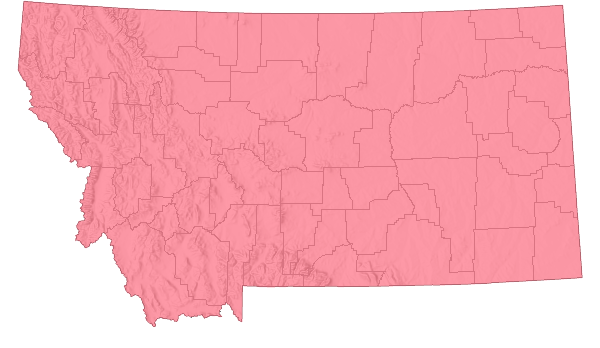
 Non-native
Non-native
Range Comments
Native Range: central and southern Europe, Asia Minor, the Caucasus and southwestern Siberia. In Europe, most common in the Balkans, southeastern Austria, parts of Germany and Switzerland (in Switzerland from at least 450 m to 1500 m elevation); rare in Portugal and Spain (Schroeder 1980).
North America: Introduced as a biological control agent against Leafy Spurge (Euphorbia esula complex) in Canada and the US: Oregon and Wyoming in 1980-1982, Montana in 1982-1984. Additional releases during 1988-1996. Established in Colorado, Montana, North Dakota, Oregon, and South Dakota, but failed in Idaho, Iowa, Michigan, Minnesota, Nebraska, Washington, Wisconsin, and Wyoming (Rees et al. 1996; Hansen et al. 1997). Original Montana releases in Gallatin, Richland, and Stillwater counties, subsequently in other counties (Rees et al. 1986; Hansen et al. 1997). Now documented in Montana from at least 24 counties mostly in the western 1/2 of the state, but including Custer, Richland, and Valley counties in the eastern 1/4 (Hart et al. 2013); populations in all of these counties may not be extant or self-sustaining.
Observations in Montana Natural Heritage Program Database
Number of Observations: 32
(Click on the following maps and charts to see full sized version)
Map Help and Descriptions
Relative Density
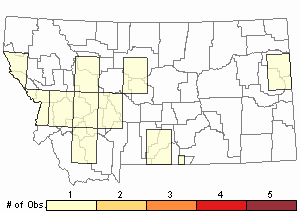
Recency
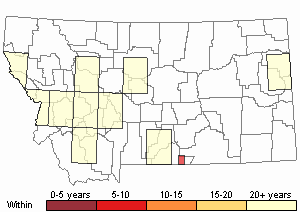
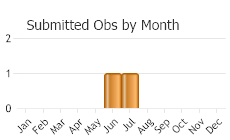
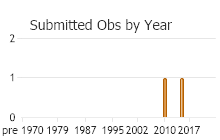
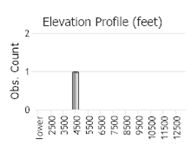 (Observations spanning multiple months or years are excluded from time charts)
(Observations spanning multiple months or years are excluded from time charts)
Migration
Not described; probably non-migratory.
Habitat
Uncultivated fields, pastures, rangelands, and cultivated croplands where
Leafy Spurge (Euphorbia esula) and related
Euphorbia species present; established best in riparian areas with some tree cover (Schroeder 1980; Rees et al. 1986; Rees et al. 1996; Hansen et al. 1997; Lajeunesse et al. 1997).
Food Habits
Host plants restricted to
Euphorbia. Reported larval and adult host plants in Europe include several species, especially
E. cyparissias,
E. esula,
E. seguieriana, and
E. virgata (Schroeder 1980). Adults also feed, girdle, and oviposit on North American exotics of
E. amygdaloides,
E. cyparissias,
E. esula,
E. polychroma,
E. serratula, and
E. virgata; adults rarely feed on the ornamentals
E. milii,
E. myrsinites, and
E. pulcherrima. Larvae develop only on
E. cyparissias,
E. esula,
E. seguieriana, and
E. virgata. In feeding trials, larval develpment normal on
E. amygdaloides,
E. cyparissias,
E. esula, and
E. virgata, other
Euphorbia species ignored, with possible exception of
E. polychroma (Schroeder 1980). In transfer tests, L1 instar larvae placed in artificial mines on 24 genera (31 species) of potential host plants developed to L3 instar only on hybrid
Chrysanthemum,
Euphorbia polychroma, and
Lythrum salicaria (Schroeder 1980). On
Euphorbia, L1-L3 or L4 instar larvae feed within stem pith before reaching root crown, later instar larvae feed in root crown and upper part of main root; most adult feeding on host plant stems and leaves, less often on inflorescences (Schroeder 1980; Rees et al. 1986). In Montana, beetles reared from
E. cyparissias,
E. esula, and
E. virgata will feed on
E. esula (Rees et al. 1986).
Reproductive Characteristics
Adults sexually immature for about 14 days after emergence. Adult lifespan about 21-56 days; females produce 20-60 eggs during adult stage. Females girdle host plant stem and usually deposit a single egg in a chewed hole above the girdle. Eggs hatch in 7-10 days after oviposition, larvae develop through about 5 instars, prepare pupal cell in root crown of host plant at ground level or just above, pupate in May. Larvae feed in stem pith, L1-L3 or L4 instars consume all pith, only a single larva develops per stem, but several may complete development in large plants with well developed root crowns (Schroeder 1980; Rees et al. 1996; Hansen et al. 1997)
Management
Biological control agents are most effective when integrated with other biocontrol and traditional methods (Lajeunesse et al. 1997; Lym 2005). This approach applies to use of
Oberea erythrocephala for controling leafy spurge. Although this biocontrol agent has potential to greatly depress leafy spurge populations, it attacks only specific biotypes of spurge, which inhibits beetle population growth sufficiently in many areas to greatly reduce its effectiviness. Adult feeding on host leaves and stems does not greatly affect leafy spurge survival. However, girdling and subsequent egg-laying by adult females results in shoot death. Larval feeding in stem pith causes stem death, and larval feeding in root crown and roots greatly reduces the plant's root reserves. Larvae live and feed in host plants with stem diameters >3.0 mm (Rees et al. 1996).
The following general suggestions (from Lajeunesse et al. 1997) may help insure successful collection and establishment of biocontrol insects:
1) Determine beforehand the habitat requirements for biocontrol insects to be used. Avoid sites with high ant and grasshopper populations, and seek areas free from grazing, herbicide or pesticide use. Initial release sites should be protected for up to 10 years, secondary sites need less protected time.
2) Collection should be made with minimum stress to the insects. Beetles can be collected by using a sweep net through the upper portions of leafy spurge plants 8-10 times, then dumping content into a container.
3) Release insects as quickly as possible. If moved more than 80 km or held for more than a few hours, the biocontrol species should be sorted out from other species of arthropods captured during sweeping. Biocontrol insects should be kept cool during transport through use of a cooler with refrigerated (not frozen) coolant packs.
4) Release biocontrol insects during the cool parts of a day by sprinkling over a small area (10-15 square meters) on a leafy spurge infestation of moderate density. Avoid tall, dense stands that may provide too much shade and high humidity.
5) Permits are required to transport biocontrol insects across state or provincial borders; in Montana, permits can be obtained from the Montana Department of Agriculture.
Specifically to
Oberea erythrocephala, adult beetles are the life stage to transfer and introduce. Adults can be obtained by sweep-netting or hand-collecting at sites with established beetle populations. These can be stored for up to several weeks if kept cool and then allowed to warm up three times per week for two-hour periods to exercise and feed. They can be shipped in a cool environment with plant stems and leaves for food. However, release should occur within six days once shipped (Rees et al. 1996). They should be released directly on the leafy spurge plants (Lajeunesse et al. 1997)
Melissa Maggio-Kassner is the coordinator for the Montana Biological Weed Control Project. She can be reached at (406) 258-4223 or
mmaggio@missoulaeduplace.orgUseful Links:Montana Invasive Species websiteMontana Biological Weed Control Coordination ProjectMontana Department of Agriculture - Noxious WeedsMontana Weed Control AssociationMontana Weed Control Association Contacts Webpage.
Montana Fish, Wildlife, and Parks - Noxious WeedsMontana State University Integrated Pest Management ExtensionWeed Publications at Montana State University Extension - MontGuidesStewardship Responsibility
References
- Literature Cited AboveLegend:
 View Online Publication
View Online Publication Hansen, R.W., R.D. Richard, P.E. Parker, and L.E. Wendell. 1997. Distribution of biological control agents of leafy spurge (Euphorbia esula L.) in the United States: 1988-1996. Biological Control 10:129-142.
Hansen, R.W., R.D. Richard, P.E. Parker, and L.E. Wendell. 1997. Distribution of biological control agents of leafy spurge (Euphorbia esula L.) in the United States: 1988-1996. Biological Control 10:129-142. Hart, C.J., J.S. Cope, and M.A. Ivie. 2013. A Checklist of the Cerambycidae (Coleoptera) of Montana, USA, with Distribution Map. The Coleopterists Bulletin. The Coleopterists Society. 67(2): 133-148
Hart, C.J., J.S. Cope, and M.A. Ivie. 2013. A Checklist of the Cerambycidae (Coleoptera) of Montana, USA, with Distribution Map. The Coleopterists Bulletin. The Coleopterists Society. 67(2): 133-148 Lajeunesse, S., R. Sheley, R. Lym, D. Cooksey, C. Duncan, J. Lacey, N. Rees, and M. Ferrell. 1997. Leafy spurge: biology, ecology and management. Bozeman, MT: Montana State University Extension Service Bulletin EB-134. 25 p.
Lajeunesse, S., R. Sheley, R. Lym, D. Cooksey, C. Duncan, J. Lacey, N. Rees, and M. Ferrell. 1997. Leafy spurge: biology, ecology and management. Bozeman, MT: Montana State University Extension Service Bulletin EB-134. 25 p. Lym, R.G. 2005. Integration of biological control agents with other weed management technologies: successes from the leafy spurge (Euphorbia esula) IPM program. Biological Control 35:366-375.
Lym, R.G. 2005. Integration of biological control agents with other weed management technologies: successes from the leafy spurge (Euphorbia esula) IPM program. Biological Control 35:366-375. Rees, N.E., R.W. Pemberton, A. Rizza, and P. Pecora. 1986. First recovery of Oberea erythrocephala on the leafy spurge complex in the United States. Weed Science 34:395-397.
Rees, N.E., R.W. Pemberton, A. Rizza, and P. Pecora. 1986. First recovery of Oberea erythrocephala on the leafy spurge complex in the United States. Weed Science 34:395-397. Rees, N.E., R.W. Pemberton, N.R. Spencer, P.C. Quimby, Jr., and R.M. Nowierski. 1996. The spurges pp. 155-186 In: N.E. Rees, P.C. Quimby, Jr., G.L. Piper, E.M. Coombs, C.E. Turner, N.R. Spencer, and L.V. Knutson (eds). Western Society of Weed Science. Bozeman, MT: Montana State University.
Rees, N.E., R.W. Pemberton, N.R. Spencer, P.C. Quimby, Jr., and R.M. Nowierski. 1996. The spurges pp. 155-186 In: N.E. Rees, P.C. Quimby, Jr., G.L. Piper, E.M. Coombs, C.E. Turner, N.R. Spencer, and L.V. Knutson (eds). Western Society of Weed Science. Bozeman, MT: Montana State University. Shroeder, D. 1980. Investigations on Oberea erythrocephala (Shrank) (Col;Cerambycidae), a possible biocontrol agent of leafy spurge Euphorbia spp. (Euphorbiaceae) in Canada. Zeit. fur ang. Ent. 90:237-254.
Shroeder, D. 1980. Investigations on Oberea erythrocephala (Shrank) (Col;Cerambycidae), a possible biocontrol agent of leafy spurge Euphorbia spp. (Euphorbiaceae) in Canada. Zeit. fur ang. Ent. 90:237-254.
- Additional ReferencesLegend:
 View Online Publication
View Online Publication
Do you know of a citation we're missing? Sater, S. 2022. The insects of Sevenmile Creek, a pictorial guide to their diversity and ecology. Undergraduate Thesis. Helena, MT: Carroll College. 242 p.
Sater, S. 2022. The insects of Sevenmile Creek, a pictorial guide to their diversity and ecology. Undergraduate Thesis. Helena, MT: Carroll College. 242 p.
- Web Search Engines for Articles on "Red-headed Leafy Spurge Stem Borer"
- Additional Sources of Information Related to "Insects"





